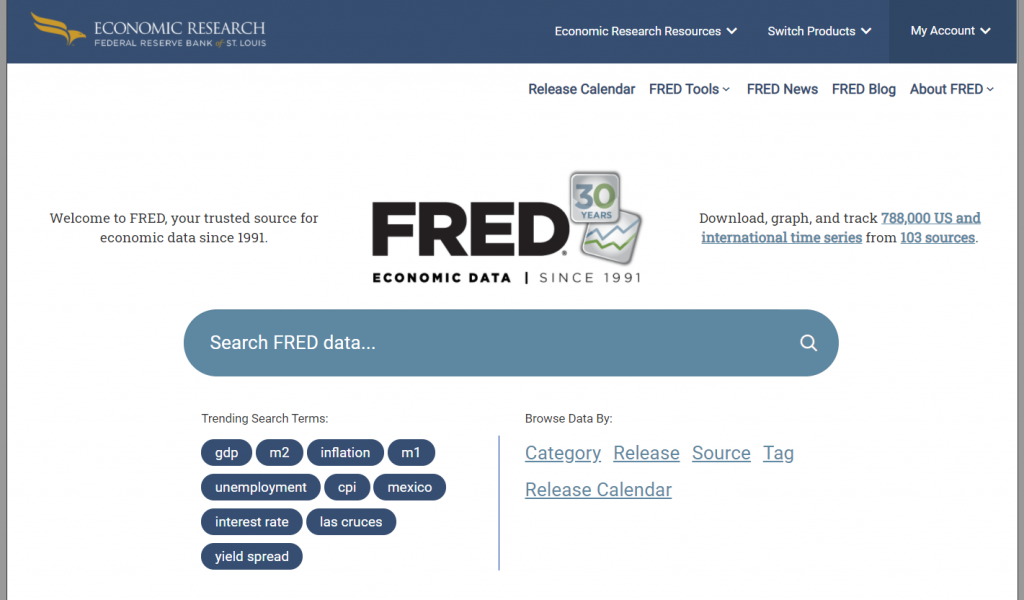FRED has added over 19,500 new series on industry productivity from the Bureau of Labor Statistics. This dataset includes series from the following labor and multifactor productivity press releases:
Federal Reserve Economic Data
Announcements
FRED Adds Industry Productivity Dataset from Bureau of Labor Statistics
FREDcast Will Be Retired in August 2021
Dear FREDcast players,
Thank you for being a part of our FREDcast community. We’ve enjoyed all the great economic forecasting over the past 5 years.
After carefully assessing regular usage and the resources we must commit to supporting this product, we have decided to discontinue FREDcast.
The June forecasting period (from May 21, 2021, until June 20, 2021) will be the last one to enter your forecasts. The scoring of forecasted values will occur on July 2, 2021, for unemployment rate and payroll employment; on July 13, 2021, for CPI inflation; and on July 29, 2021, for the real GDP growth rate.
The FREDcast website will be unavailable after August 1, 2021.
We know a change like this can be disruptive, especially for those who have used FREDcast as a teaching tool. We’d like to suggest some alternatives to engage your students with current events and FRED data.
- Econ Lowdown recently added short reading Q&As by adapting material from the FRED Blog. Consider using this post on the uneven impact of the COVID-19-induced recession on the unemployment rates of men and women as a pre-lecture assignment.
- You can also improve your students’ graph-building and graph-reading skills by using FRED Interactives in Econ Lowdown. This module uses live data from FRED to calculate U.S. GDP per capita and compare it with China’s GDP per capita.
- Student work on both the FRED Blog readings and FRED Interactives is automatically graded and imported into your Canvas LMS gradebook. Learn how to make it happen here.
As always, thank you for your continued trust in the economic resources from the Federal Reserve Bank of St. Louis.
FRED Adds U.S. Mortgage High Yield Indexes from Andrew Davidson and Co.
These 10 index series from Andrew Davidson & Company (AD&Co) track the total return of the bonds issued within the CRT programs of Fannie Mae and Freddie Mac. The U.S. Mortgage High Yield Indexes is an informational, investment-oriented monthly index of the return components: price, coupon, paydown, and credit loss. Accompanied by standard risk metrics from their models, the index is useful for comparisons with individual CRT bonds or relative value to other credit markets.
The crOAS (credit-and-option-adjusted spread) series are an extension of the traditional OAS measure. On a set of 20 standardized, probabilistically weighted, market-and-model stress scenarios, AD&Co computes a discount rate that equates expected present value of a tranche’s cash flows to the observed market price; the cash flows are loss-adjusted using AD&Co’s LoanDynamics Model (LDM).
Disclaimer: The AD&Co U.S. Mortgage High-Yield Index serves as an informational index and is not for commercial-use purposes. The Index’s accuracy, completeness, timeliness, and suitability for any purpose are not guaranteed. The Index does not constitute (1) investment, legal, accounting, tax, or other professional advice or (2) any recommendation or solicitation to purchase, hold, sell, or otherwise deal in any investment. This Index has been prepared for general informational purposes, without consideration of the circumstances or objectives of any particular investor. Any reliance on the Index is at the reader’s sole risk. All investment is subject to numerous risks, known and unknown. Past performance is no guarantee of future results. For investment advice, seek a qualified investment professional. Not for redistribution without permission. Note: An affiliate of Andrew Davidson & Co., Inc. engages in trading activities in investments that may be the same or similar to those featured in the Index.
Chicago Fed’s Midwest Economy Index To Be Discontinued in June 2021
The Federal Reserve Bank of Chicago has announced they will discontinue the Midwest Economy Index (MEI) after its June 2021 release, given the discontinuation of several underlying data series and the impact the COVID-19 pandemic has had on the remaining series since March 2020.
The MEI release will continue to be updated regularly on FRED for the two remaining release dates, May 28 and June 30, 2021.
More information about the discontinuation of the MEI is available on the Chicago Fed’s MEI home page.
FRED Adds Brave-Butters-Kelley Indexes
FRED has added the Brave-Butters-Kelley Indexes (BBKI), a research project from the Federal Reserve Bank of Chicago. The BBK Coincident and Leading Indexes and Monthly GDP Growth for the U.S. are constructed from a large panel of monthly measures of real economic activity and quarterly real GDP growth. Monthly GDP growth is indexed to the quarterly estimates from the U.S. Bureau of Economic Analysis and consists of three components: cycle, trend, and irregular components.
Explore the monthly and quarterly BBK indexes in FRED here.
FRED Adds Index of Global Real Economic Activity
This index from the Dallas Fed, developed by Lutz Kilian, measures global real economic activity in industrial commodity markets. This business-cycle index is expressed in percent deviations from trend. It is derived from a panel of dollar-denominated global bulk dry cargo shipping rates and may be viewed as a proxy for the volume of shipping in global industrial commodity markets.
For further discussion of the advantages of this index compared with measures of global real GDP or global industrial production, see Kilian and Zhou (2018).
FRED Adds U.S. Patent Data
FRED has added two releases from the United States Patent and Trademark Office (USPTO) with over 4,000 series on patents granted in the U.S.
The first release, U.S. Granted Utility Patents by Counties and CBSAs, has U.S. granted utility patents originating in U.S. counties and U.S. core-based statistical areas from 2000 to 2015.
The second release, U.S. Granted Patents by States, Territories, and Countries, has U.S. granted patents originating in U.S. states/territories and foreign countries from 1992 to 2019. Patents granted are also broken down by patent type: utility, plant, design, and reissue patents.
FRED Adds New National Rate Cap Series
These 53 series represent the changes that the FDIC implemented after redefining the “national rate” as follows: the average of rates paid by all insured depository institutions and credit unions for which data are available, with rates weighted by each institution’s share of domestic deposits.
On December 15, 2020, the FDIC Board of Directors approved a final rule making certain revisions to the interest rate restrictions applicable to less-than-well-capitalized institutions (as defined in Section 38 of the Federal Deposit Insurance Act), which are effective on April 1, 2021. The interest rate restrictions generally limit a less-than-well-capitalized institution from soliciting deposits by offering rates that significantly exceed rates in its prevailing market.
Users are encouraged to read the previously mentioned documentation, as well as view the release tables.
FRED and ALFRED Celebrate New Milestones!


We’re pleased to announce that FRED is celebrating 30 years as a trusted leader in providing economic data! And archival FRED (ALFRED) is celebrating 15 years of storing real-time vintages of FRED data!
The invitation list for this celebration includes you, of course, and 788,000 of our closest friends. (That is, our data series.) Additional “guests” will trickle in over time.
We’re marking this milestone with an update to the FRED website header, which includes FRED-specific content such as Release Calendar, FRED Blog, and About FRED. It also gives credit to our parent, the St. Louis Fed’s Research Division, and sibling websites, all under the heading Economic Research Resources.


Notice the new trending search terms on the FRED homepage? This list of the most-looked-for data in FRED is updated twice per day to provide you with the most relevant and timely data info.
We’re happy we can continue to enhance these data services and provide valuable resources for your data needs. Help us celebrate by testing out these new features and let us know if you have any birthday data wishes.
Teaching the Economics of Information | Bring FRED into the Classroom | April 2021
Focus on Employment in Data Processing, Hosting, and Related Services
This assignment provides instructions on building the graph below and includes writing prompts for out-of-class assignments.
Using GeoFRED® to Compare Internet Use Across Countries
This assignment provides instructions on creating the map below and suggests prompts for in-class discussion. See how you do on our sample discussion question below.
Click on the map above to view an interactive version.
Question: Name three countries where fewer than 20 of every 100 persons have access to the internet.
Learning About the Economics of Information to Forecast Changes in Gross Domestic Product
In the fourth quarter of 2020, real gross domestic product increased. Read on for more details and a list of resources to become a better FREDcast forecaster.
BEA Headline:
According to the Bureau of Economic Analysis, “Real gross domestic product (GDP) increased at an annual rate of 4.1 percent in the fourth quarter of 2020.”
Release Spotlight:
“The digital economy accounted for 6.9 percent of the U.S. gross domestic product, or $1.35 trillion, in 2017.”
https://www.bea.gov/news/blog/2019-04-04/digital-economy-accounted-69-percent-gdp-2017
Resources to become a better FREDcast forecaster:
- Review: “FRED®, the St. Louis Fed’s Force of Data.“
- Review: “The Diffusion of Electronic Business in the United States.“
- Economic Synopses: “Taxing Electronic Commerce: Boon or Boondoggle?“
- FRED Blog: “What the young and old spent on reading materials: 2019 vs. 1984.“
Quiz Yourself on Different Aspects of the Economics of Information
The graph above shows spending on reading for seven age groups.
Q1. As of 2019, which age group spent the most on reading?
Q2. As of 2019, which age group spent the least on reading?
The map above shows the number of persons employed in the information industry in each U.S. metropolitan statistical area (MSA).
Q1. As of 2020, where are most people employed in the information industry located—on the coasts or on the interior?
Q2. As of 2020, where are most people employed in the information industry located—in Los Angeles-Long Beach-Anaheim Metro or in New York-Newark-Jersey City Metro?
Q1. Name two industrial sectors where the producer price index for advertising space and time sales in 2020 is above its 2010 value.
Q2. In which industrial sector has the producer price index for advertising space and time sales constantly declined since 2010?
Now that you’ve aced this quiz, give it to your students using this dashboard. To customize this dashboard, just click the “Save to My Account” button at the top of the dashboard.

